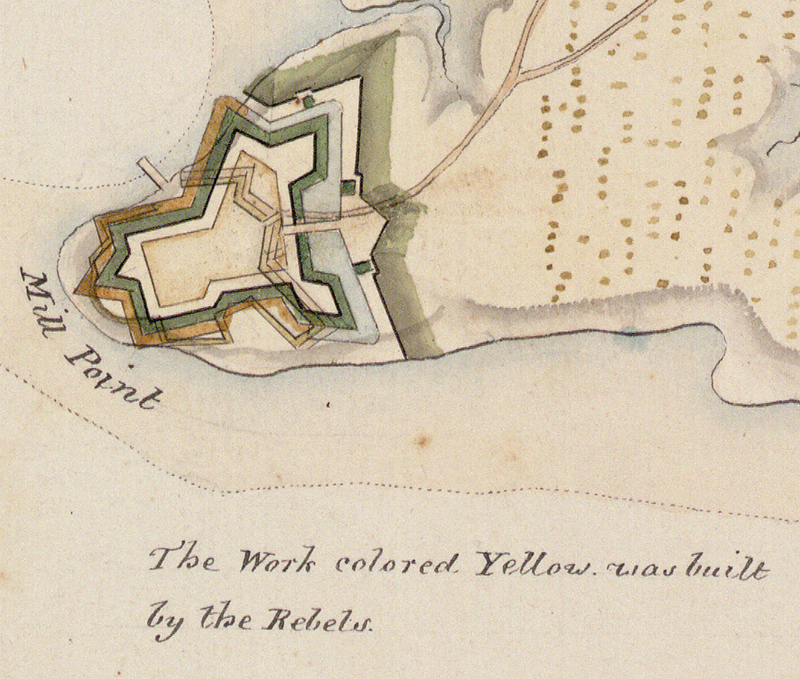
Defending Norfolk and Portsmouth 1776
When the American Revolutionary War began the Borough of Norfolk did not have a fort to protect it. On New Years Eve 1775 Lord Dunmore’s forces fired on rebels in Norfolk and set fire to buildings along the waterfront. The rebels then proceeded to burn burn the rest of the buildings in Norfolk. St. Paul's Episcopal Church is the only surviving original structure and it still has one of Lord Dunmore’s cannon balls in its wall.
Major General Charles Lee wrote to George Washington on April 5, 1776 "had I only eight eighteen Pounders I wou’d immediately at all events take post on Crany Island, by which measure I shoud drive out the Enemy and exclude em from the finest and most advantageous Port in America —I have order’d with this view the Artificers to work night and day"
During the American Revolution, Virginia troops built Fort Nelson, situated on the Windmill Point plantation of Robert Tucker III, now the site of the Portsmouth Naval Hospital. Fort Nelson was finished only on the water side, and entirely open in its rear. Its structure was extremely simple, yet strong. Parallel rows of large logs of timber were closely dove tailed together, and the intermediate space filled with hard rammed earth - the whole presenting a front 14 feet high, 15 feet thick, and proportionately long. Major Thomas Matthews commanded in this post, with about 150 men, some heavy cannon and a few field pieces.
On May 10, 1779 the British fleet which consisted of the Raisonable of 64 guns, the Rainbow, Otter, Diligent, Haarlem Sloop, Cornwallis's galley, and some private vessels of war, and transports. The force which contained about 2,000 troops sailed down the Elizabeth River and landed men north of Fort Nelson to attack the fort from the rear.
Major Thomas Matthews realized that he could not defend the fort from this size force and abandoned the fort.
After seizing the town of Portsmouth, the British demolished Fort Nelson. The British infantry commander, Major General Edward Mathew, reported that "the Engineer has been employed for many Days, with near one Hundred Blacks, to destroy the Fort, which was so substantially constructed, as to give us a great Deal of Trouble in the Demolition" (quoted in Clary 1990:8).
The picture above is a small part of "A Plan of Portsmouth Harbor in the Province of Virginia showing the Works erected by the British Forces for its Defence 1781"
More History
Back, 1673, 1775, 1787, 1789, Army before 1793, 1793, 1794, More 1794, First Fort, 1795, 1796-1800, 1801-1806, 1807, 1808-1811, 1812, 1813, 1813-1814, 1816, 1817-1818, 1820-1821, 1824, 1835, 1842-1844, 1845, 1849, 1851, 1852, 1853, 1854, 1854 Keeper's House, 1854 Changes, 1858, 1859, 1861, 1862, 1864, 1875, 1884, 1893, 1903, 1923, Next
Source of Information
A CULTURAL RESOURCE MANAGEMENT PLAN OF FORT NORFOLK, NORFOLK, VIRGINIA prepared for U.S. Army Corps of Engineers, Norfolk District by the College Of WILLIAM & MARY, November 1995 under Contract No. DACW65-94-Q-0075.
David A. Clary's Fortress America: The Corps of Engineers, Hampton Roads, and United States Coastal Defense (1990)
William Bradshaw and Julian Tompkins's Fort Norfolk, Then and Now (n.d.).
The Norfolk Public Library vertical file of recent newspaper articles on Fort Norfolk. Including articles by James Melchor of the U.S. Army Corps of Engineers that describe archaeological and architectural findings on the fort property.
